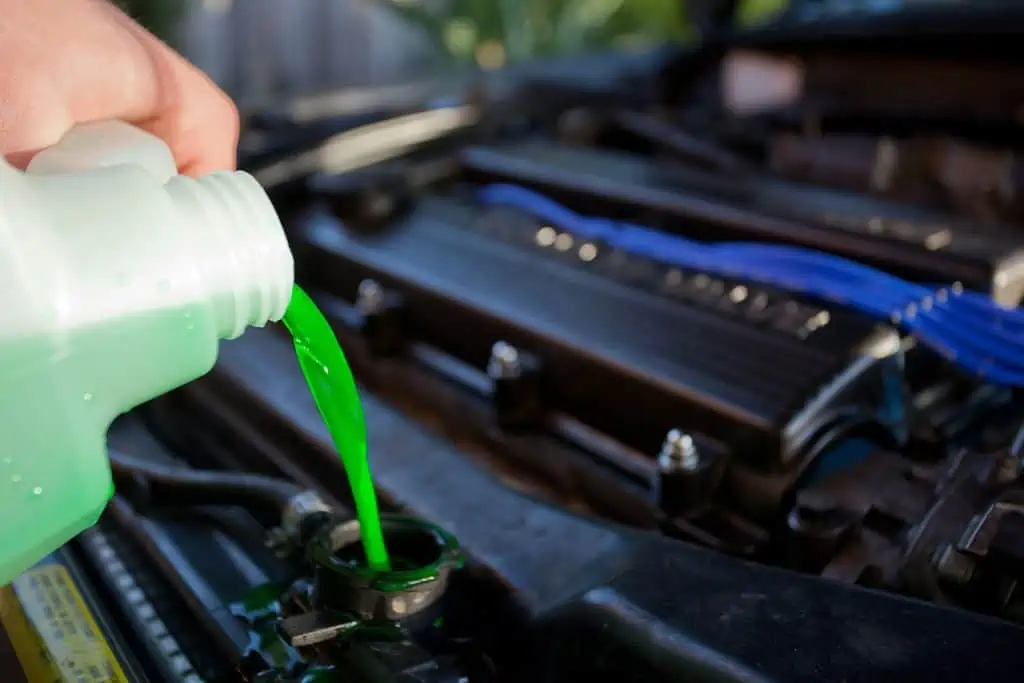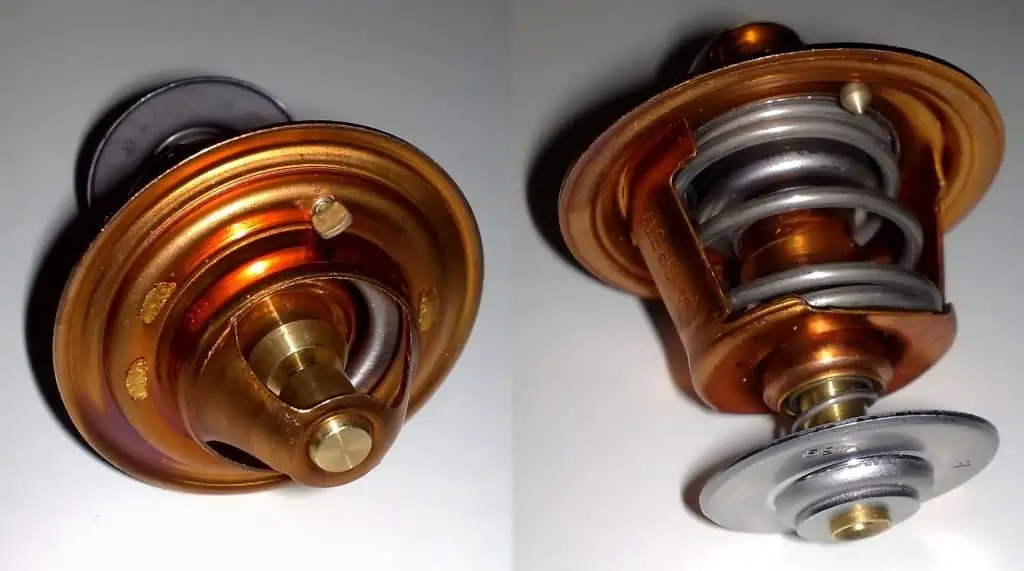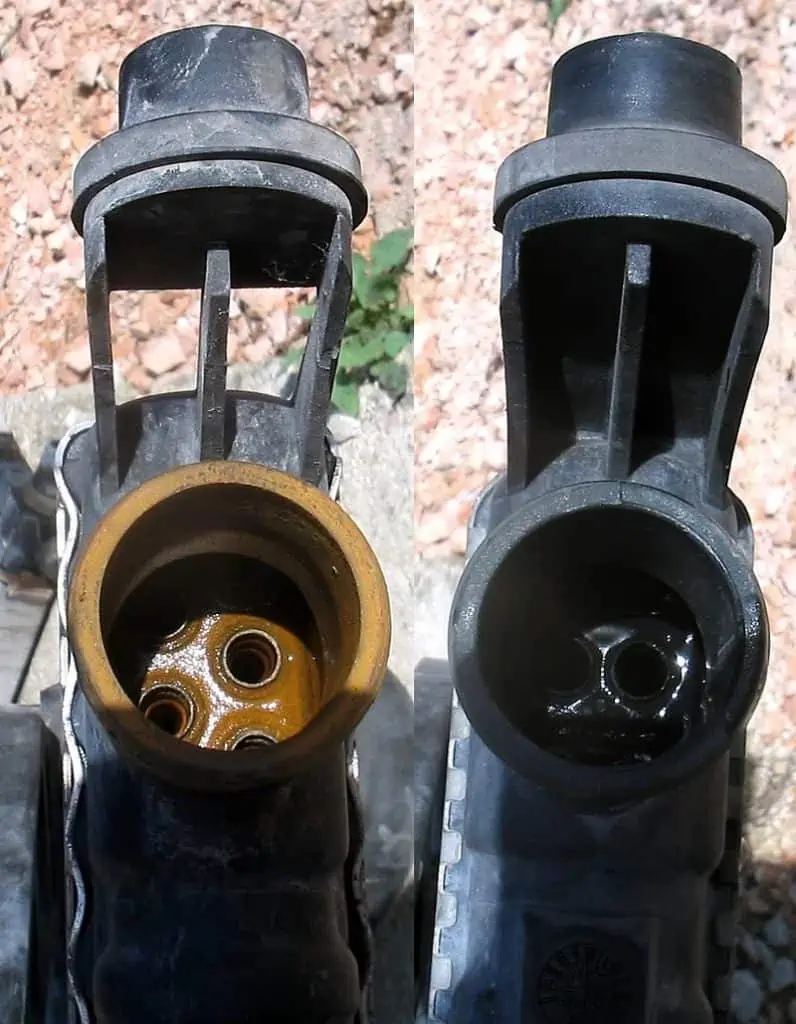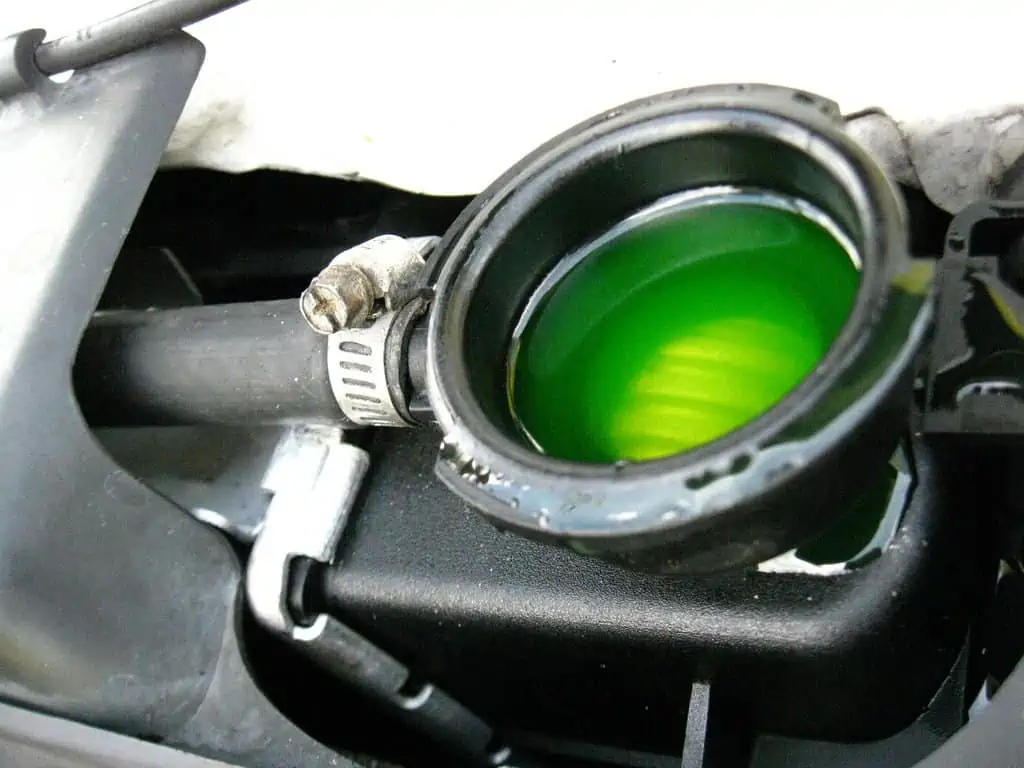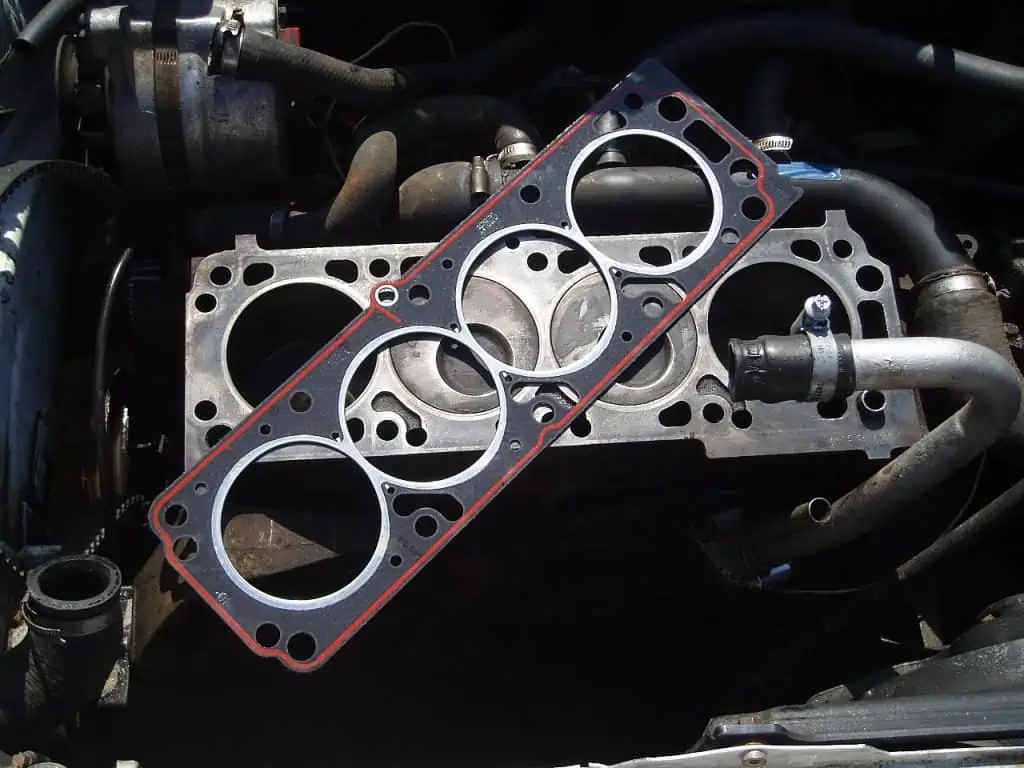When your car’s engine reaches those high temperatures in the middle of a long drive, it can only continue to run because of the radiator. Your engine generates a lot of heat, up to 2,500 degrees Fahrenheit, as a result of friction and fuel combustion.
The radiator’s purpose is to maintain the engine’s temperature within a safe range without overheating. The coolant circulates from the radiator through your engine, soaking up all the extra heat, before returning to the radiator to cool down. This ongoing, circular process keeps everything functioning properly and as it was intended to.
It goes without saying that if you have a radiator issue, this will hurt your ability to cool the engine. If nothing is done to address an overheating engine, it will eventually fail. An engine overheating can result in severe damage, including blown gasket heads, damaged cylinders, and other things.
If engine overheating is allowed to continue for an extended period, you may incur expenses of up to $4,000 or more. If at all possible, try to avoid having to make that repair. And this is something you want to know about if the issue was caused by a clogged radiator, which is something that can be fixed for a very low cost.
There’s a good chance that your radiator is clogged if you start to experience a few of these symptoms. If that is the case, we can inform you of the necessary action. But first, consider all the indications that something is wrong that your clogged radiator will give you.
What Is the Purpose of a Radiator In a Car?
Every new car owner is aware that an engine generates a lot of heat while it is running. The performance of the engine itself, as well as the proper operation and lifespan of every other component located under the hood of your car, are adversely affected by prolonged exposure to excessive heat. Any type of machinery should never be exposed to excessive heat.
A typical engine coolant radiator by MGTom. The radiator’s job is to prevent the engine from overheating while keeping the temperature within a safe range. After passing through your engine and absorbing all the excess heat, the coolant flows back to the radiator to cool.
There needs to be a reliable system in place to keep the engine cool enough to guarantee smooth operation. With the aid of engine coolant, the radiator serves this purpose.
The coolant in a car’s engine absorbs heat and transmits it to the radiator, where the hot coolant cools by evaporating. After cooling, the coolant is reinjected into the engine to complete the cycle. To put it another way, a radiator is a type of heat exchanger.
For the majority of vehicle engines, the safe operating range is between 195 and 220 degrees Fahrenheit. It’s acceptable to occasionally exceed that upper limit, particularly during the warmer months when the air conditioning is heavily utilized. However, prolonged, excessive engine heating is a big no-no.
The majority of modern engines are air-cooled liquid-cooled, which means they use a liquid coolant that is circulated through a heat exchanger (thus you can say they are partly air-cooled). Other engines use air cooling, which uses a gaseous coolant rather than a liquid one.
A Clogged Radiator: What Causes It?
Your car may have a clogged radiator as a result of rust, gradual internal deposit buildup, or debris or contaminants becoming lodged inside the radiator. Such obstructions will limit the radiator’s ability to cool by preventing the proper flow of coolant between it and your engine.
Old radiator coolant that has been sitting around for extended periods without being changed or when the engine hasn’t been running for a while are the two main causes of a clogged radiator. An obstruction in the radiator’s tubes and fins caused by old coolant prevents coolant from flowing to and from the radiator.
A cooling system that hasn’t been regularly maintained and “flushed” could also introduce contaminants that lead to blockages. At the end of this guide, you will find instructions on how to flush the radiator to remove or prevent blockages.
A defective radiator that is not functioning properly will cause major problems. Engine overheating would always result from a clogged radiator.
What are the Common Clogged Radiator Symptoms In a Car?
You may have a clogged radiator for several reasons, just like any system with a liquid flowing through it. Your engine won’t be able to maintain a temperature if there is not enough coolant flowing through the lines.
A radiator can become clogged from the outside as well, so there are a few signs to watch out for that will let you know what’s wrong.
1. The Temperature Gauge Records High Readings
A temperature gauge on the dashboard is informing you that the radiator is overheating, so let’s start with that as the most obvious indication that something is wrong.
Usually, that gauge is situated near your fuel gauge or odometer, but no matter where it is, it will have a needle that oscillates between the letters C and H. The engine is overheating if it starts to move in the direction of the red mark on the H.
When you notice that needle sitting higher than normal, especially if it enters the red zone, you know you have a problem that needs to be fixed immediately because your engine should typically be running at about the same temperature.
The coolant is poured into the radiator by fir0002 GFDL1.2. Heat is absorbed by the coolant in an automobile’s engine and transferred to the radiator, where the heated coolant cools by evaporating. The cycle is finished by reinjecting coolant into the engine after cooling. Another way to say it is that a radiator is a kind of heat exchanger.
Between 195 and 220 degrees Fahrenheit should be the ideal temperature for your car. Any variation above that level shouldn’t raise too many red flags. Still, if it consistently rises above that level for a prolonged amount of time, a clogged radiator could potentially be to blame.
When your radiator begins to corrode, the internal rust can accumulate and become stuck in the radiator, obstructing the flow of coolant back to your engine. This issue is typically resolved for you by a good flush.
2. A Discolored Coolant
A change in the coolant’s characteristics, which most likely means it is contaminated, is another sign of a clogged radiator. You should make it a point to check the coolant as part of your routine maintenance to see if it needs to be refilled and to check its color, viscosity, and smell.
Bright green or yellow should be the color of the coolant. Make sure you are aware of the color of your coolant because there are various other colors of coolant available, such as pink, blue, and purple. The typical thickness of coolant permits free flow within the cooling system.
The coolant can become contaminated over time by internal deposits, sludge, or external contaminants (such as those in tap water), which usually causes it to become rustier in hue. Because it is contaminated, it will be significantly thicker than usual, which will slow its flow and lead to blockages.
Checking the coolant overflow tank is the simplest way to determine the color and viscosity of the coolant (you should have a coolant overflow tank that you can easily access and quickly inspect). To avoid problems as a result of a clogged radiator, you must thoroughly flush the system if you notice a significant change in color and/or thickness.
While coolant should have a distinct sweet smell, contaminated coolant would smell somewhat like rubber in addition to changing in color and viscosity.
As an aside, some cars have a transmission cooler that is housed inside the radiator. The coolant and transmission fluid would mix if there is a leak in the wall separating them, which would result in double the problems.
3. Existence of Coolant Leaks
The cooling fins of the radiator may develop minute holes or cracks, which could result in coolant leaks if the radiator becomes clogged due to severe corrosion brought on by contaminated coolant.
You might notice obvious coolant leaks on your garage floor or driveway, and/or your dashboard may be illuminated by the low coolant level light. This is the second most obvious and typical indication that your radiator is clogged.
Once you frequently add tap water to the coolant mixture rather than distilled water because tap water has many contaminants, you may be contributing to radiator corrosion.
If rust is indeed the source of the coolant leak, you must have it fixed right away because leaks like these only get worse over time and may even permanently harm the radiator.
Your car will have to operate with insufficient coolant if there is even a small coolant leak, which will result in less-than-ideal performance. Your engine could overheat if the problem is left unattended, which would necessitate costly repairs.
Evaluate the color of a leaking fluid to confirm that it is coolant and not another type of fluid from the car, as you should do every time. The majority of coolants have a distinct scent that is somewhat “sweet.”
Car engine thermostat by Hoikka1 / CC BY-SA 3.0. A blocked radiator prevents hot coolant from the heater core from heating the cabin enough. Incorrect heater functioning is one of the common symptoms of a blocked radiator, even though a damaged thermostat is more likely to be to blame.
If it’s coolant, try to get rid of it as soon as you can because it’s toxic and will draw animals to drink it. To keep your engine running temporarily, identify and fix the leak as quickly as you can, or at the very least, maintain the coolant level topped off.
Please be aware that a thorough radiator flush will not be able to solve the issue if your radiator is leaking due to severe rust. You might need to replace the radiator because it may already be completely inoperable.
Having said that, the system will more likely be susceptible to corrosion and obstructions if a radiator flush is not performed regularly.
4. The Car Heater Isn’t Heating Up
The coolant that is moving from your hot engine back to the radiator gets routed through the heater core in your car so that the hot air can be pushed in and keep you warm when you switch on the heater inside and it heats the cabin on a cold morning.
A clogged radiator may be the cause of your inability to feel any warm air coming in. By no means is it the sole issue, but if you also experience any of these other signs, a clogged radiator may be to blame.
Your car’s cabin heater works by circulating hot coolant through the heater core and then blowing the heated air into the passenger compartment via a blower fan. A clogged radiator prevents enough hot coolant from reaching the heater core to adequately warm the cabin.
Even if a broken thermostat is more likely to blame, incorrect heater operation is one of the typical signs of a clogged radiator.
5. Clogged Fins
The airflow can be blocked by radiator fins for several reasons, one of which is clogging from foreign material accumulating on these fins.
The radiator fins at the front of your radiator ought should be visible. These fins are readily clogged with debris, road dust, and even tiny branches or leaves, and insects since they are outdoors and exposed to the air.
These fins are clogged if you notice white, crusty deposits corroding them. The airflow is being obstructed by these blocked fins, which is preventing the coolant from properly cooling.
Fortunately, you should be able to clean the fins with a garden hose if they are blocked with dirt and pollutants. To get access to these radiator fins, which are positioned on the front of most vehicles, it should be simple to remove one or more plastic covers.
6. Broken Fins
Radiator fins are incredibly sensitive and thin. While the vehicle is moving, it may physically come into touch with foreign objects and become twisted.
A sufficient number of bent or broken fins will cause them to flatten against the radiator. This will limit airflow, making it more difficult for your radiator to keep things cool and increasing the risk of engine overheating.
Any minor physical contact, such as a microscopic bit of grit striking the fins while driving, or even water being sprayed over the fins by a powerful pressure washer to clean them, might harm them. The removal and replacement of radiators can potentially cause damage.
Auto radiators with double grids of tubes by A7N8X / CC BY-SA 3.0. If the radiator becomes blocked owing to severe corrosion brought on by polluted coolant, the cooling fins may develop tiny holes or breaks that might cause coolant leaks.
7. Damaged or Leaking Head Gasket
A clogged radiator almost always causes engine overheating, which, if left unattended, can lead to catastrophic engine damage like a ruptured or leaky head gasket or a broken cylinder head. Repairing these damages is expensive and difficult.
The symptoms of a damaged head gasket or cylinder head include quick engine overheating, difficult engine operation, white smoke issuing from the exhaust, and excessive coolant usage.
8. Water Pump Failure
As mentioned previously, tainted old engine coolant is the main cause of a clogged radiator. The lubricating and anti-corrosive qualities of contaminated coolant are lost. The engine’s water pump may be damaged as a result, which causes the coolant to circulate improperly.
How Serious are the Symptoms of a Clogged Radiator?
Any system in your car, including the engine, suffers damage from overheating. The radiator is crucial to the functioning of your engine because it keeps the engine cool and keeps it from overheating. However, a clogged radiator that cannot operate correctly might cause significant harm.
For this reason, understanding the typical signs of a clogged radiator and how to remedy each issue is a fundamental and essential maintenance skill that you must acquire to maintain the best engine performance and to spare yourself from costly and time-consuming repairs.
A severely damaged engine might result from overheating, which can cause everything from blown gasket heads to broken cylinders.
If you don’t recognize the signs of a clogged radiator and don’t deal with overheating right away, you may have to deal with challenging and pricey repairs that can cost up to $4,000, possibly more.
However, if a clogged radiator is a real problem, fixing it would be considerably easier and less expensive.
How Much Does a Clogged Radiator Repair Cost?
The price to fix a clogged radiator is determined by a variety of variables. You might need to replace your radiator if the damage is severe enough and you can’t clean it at home with a straight flush.
Depending on the make, model, and year of your car, the price of a new radiator might vary significantly. Radiators are available for as little as $100. However, buying a new radiator for some radiators may wind up costing you as much as $900. That only applies to the component itself.
You may visit AutoZone right now to see how much a radiator for a single Chevy might cost, which can range from $100 to $500. A radiator for a Porsche, though, begins at around $450.
Depending on the type and model of your car, labor might add another $100 to $400 to the cost. A Toyota Camry may just require an hour or two of work from a technician, yet driving a Porsche to the dealer for repairs may require up to four hours.
The second thing to keep in mind is that labor expenses might differ significantly depending on where you are in the world and things like a dealer or a local technician. In comparison to smaller towns, repair expenses are often greater in large cities.
Car engine bay, with the radiator in front by Ludovic Péron / CC BY-SA 3.0. The two primary reasons for a blocked radiator are old radiator coolant that has been around for lengthy periods without being replaced and when the engine hasn’t been operating for a while. Old coolant clogs the radiator’s tubes and fins, preventing coolant from entering and leaving the radiator.
You might be able to take your car to a tire and lube shop rather than a complete repair if all it needs is a radiator cleanse. To find out what services local companies provide, you’ll need to contact them.
But those locations often charge less than mechanics would complete the work, and they frequently provide discounts to further reduce the cost. So once more, the price of a radiator flush may range from $40 to $200 depending on where you get it done.
The advantage of a radiator flush to clear a blockage is that you may also do the procedure on your own using several do-it-yourself kits. On Amazon.com, a bottle of radiator flush & cleanser only costs approximately $6.
For about $7, you can get a flush and fill kit that will enable you to thoroughly clean the whole coolant system provided you have a hose on hand. So, for less than $15, you could flush your radiator in the driveway if you have a garden hose at home.
Can I Flush a Radiator Out By Myself?
It’s not that tough to find out how to flush your radiator at home if you’ve never done it before. You should be able to tackle flushing your radiator at home if you feel confident performing tasks like replacing an oil filter or even a tire.
Of course, there are a ton of videos on the internet that can lead you through the procedure if you’ve never done it before. A guide like this will demonstrate the simple procedures you may take to flush the radiator and quickly restore functionality.
The cost of having this service done at a mechanic isn’t the highest in the world, but as we’ve shown, you can do it yourself for as little as $20, so if you have the time and the desire, it’s worthwhile to do it yourself.
A Clogged Radiator’s Flushing Procedure
The least difficult maintenance chore is flushing your radiator at home, and if you can perform simple maintenance like an oil change or tire replacement, you’ll probably find this to be a feasible effort. And if you’re still unsure, you can check out some online tutorials that may guide you through the procedure step-by-step.
Even while having this task completed by a technician isn’t the most costly option, if you have the time and the right tools, you can complete it yourself for less than $20.
To clear your clogged radiator, use the following actions:
Fluorescent green-dyed coolant in the radiator tank by EvelynGiggles / CC BY 2.0. Another indication of a blocked radiator is a change in the coolant’s properties, which most likely indicates that it is polluted. As part of your regular maintenance, you should make it a point to check the coolant to determine whether it needs to be replaced and to assess its color, viscosity, and smell.
1. Radiator Should Be Drained and Removed
- Put your car in level parking. Turn off the central heating system and allow it to finish cooling. Wait until your engine has cooled off enough (you should be able to touch the radiator without being burned).
- Put a clean bucket underneath the radiator drain petcock, which is typically found on the driver’s side of the radiator near the bottom.
- Wrap absorbent towels around and beneath the radiator’s plumbing in case things get messy.
- Start by closing the thermostatic radiator valve with an adjustable wrench, then shut off the remaining valves.
- The lockshield valve can be turned off using an adjustable wrench. When you replace the radiator, you must make the same number of counterclockwise turns as you did the first time to open the valve.
- Use the radiator key to loosen the bleed valve while keeping that bucket in place underneath the thermostatic radiator valve. This will let all of the water in the appliance out.
- Use the radiator key to unlock the lockshield valve and tilt the radiator to completely drain it.
- With the help of the radiator key, close the bleed valve before removing the radiator from the wall. Now that the clogged radiator has been removed, you can proceed to manually flush out the debris as follows.
2. The Radiator Should Then Be Flushed
- Purchase a bottle of powerful radiator flush. Remove the fill cap from the radiator, add the radiator flush, and then add fresh water to fill the remaining space. Change the cap.
- Allow the radiator flush to circulate throughout the entire cooling system for at least 15 minutes by letting the engine run. If the cooling system has a serious buildup of contaminants, you might need to run the engine for longer. After that, turn off the engine and wait for it to cool completely before moving on to the next step.
- Open the drain petcock after removing the radiator fill cap. Allow the radiator fluid to flow into the prepared bucket.
- To allow water to enter the cooling system of the car, insert a water hose inside the radiator fill cap. Hold off until the water is clear and smoothly draining. This proves that the obstruction in your radiator has been removed.
- Turn off the water and let it completely drain.
- The system can now be filled with the appropriate coolant and water until it is full. Ensure that the overflow tank is at least half full and that the radiator is filled.
- You are now finished. Replace the radiator cap. It only requires that you start the engine and look for leaks.
Head gasket on the block by Collard / CC BY-SA 3.0. The majority of the time, a blocked radiator results in engine overheating, which, if ignored, can cause severe engine damage like a burst or leaking head gasket or a damaged cylinder head. These damages are costly and challenging to repair.
3. Note of Importance
You must not yet try to operate your vehicle. To avoid the engine overheating, you must make sure all air has been drained from the system before starting the car. Allow the engine to idle for 15 to 30 minutes to do this.
A thermostatic valve opens during this period. Air pockets are eliminated from the system as the coolant and air circulate once the engine reaches a specific temperature, typically around 180°C.
While the engine is idling, feel the upper radiator hose to confirm that the thermostat has opened. The thermostat will become hot to the touch if it has opened.
During this brief period, the radiator’s coolant level will significantly decrease, so you must immediately top it off. You must remove the hot radiator cap in this step, so exercise extreme caution. The best course of action is to wait until the engine cools off once more.
Once the system is filled, replace the cap.
Alternatively, if you don’t want to wait that long, you can grab the cap with a towel. The coolant will still be slightly below boiling point, so exercise caution and move out of the way in case the cap comes off.
The Conclusion
Your car’s performance may be seriously impacted by a clogged radiator. Your bottom line will suffer if you don’t take care of a seemingly minor issue before it turns into a total engine breakdown.
There is no excuse not to give yourself a radiator flush on a semi-regular basis as part of your normal maintenance to avoid some pretty major problems down the road if you can solve this issue yourself for a little under $20.
Make sure to check your coolant levels, coolant color, and the radiator itself if you’re having any of the issues we outlined to look for any potential issues or damage that would indicate that you need to get anything addressed. A few bucks and a few hours of your time today are preferable to a huge repair cost from the technician later.
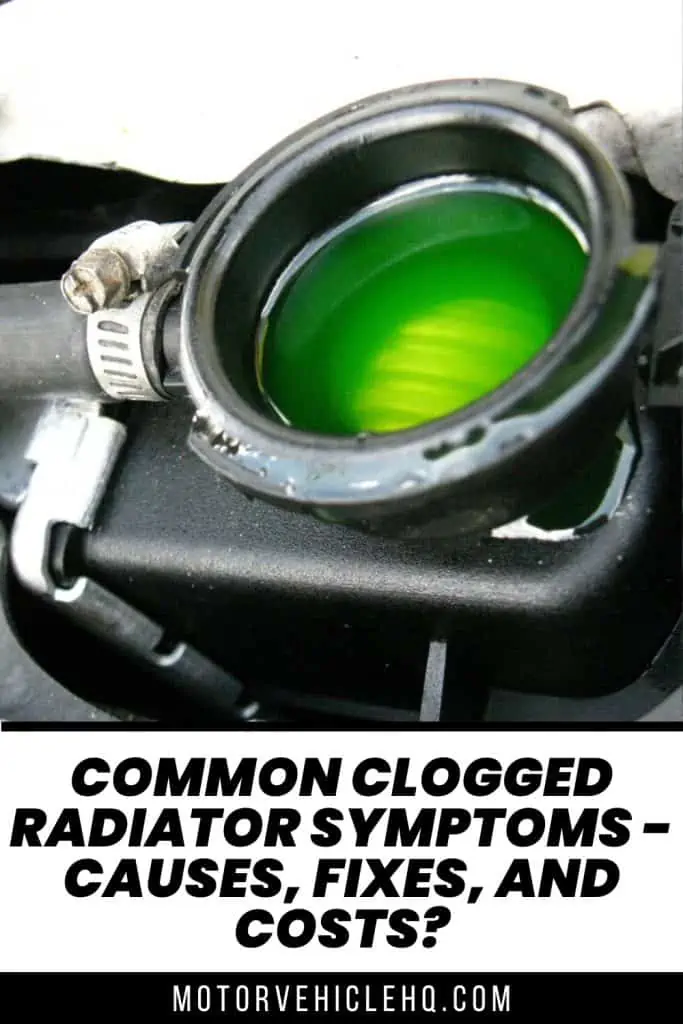
Fluorescent green-dyed coolant in the radiator tank by EvelynGiggles / CC BY 2.0

Jim Wicks is the founder of MotorVehicleHQ. With over two decades of experience in the automotive industry and a degree in Automotive Technology, Jim is a certified car expert who has worked in various roles ranging from a mechanic, car dealership manager, to a racing car driver. He has owned more than 20 cars over the past 15 years. Ask him about any vehicle you see on the road and he can tell you the make, model and year. He loves the aesthetics of all things cars, and keeps his vehicles in pristine condition.
In his free time, Jim enjoys getting his hands dirty under the hood of a classic car or taking long drives along the country roads. His favorite car? A 1967 Shelby GT500, a true classic that, according to Jim, “represents the pure essence of American muscle.”

